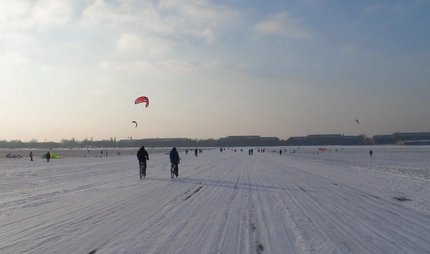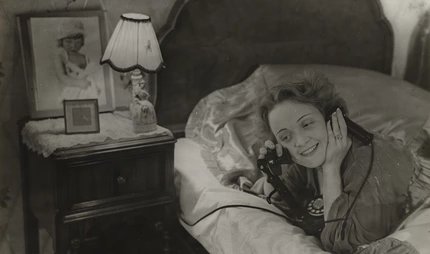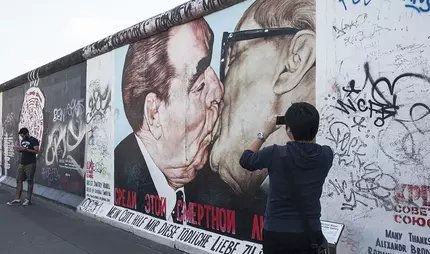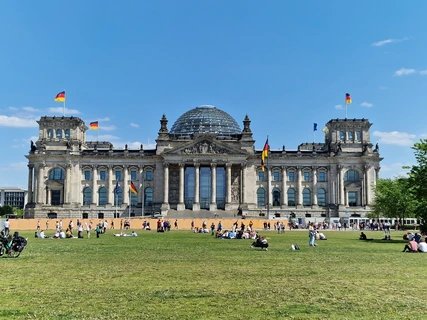
If you walk through the heart of Berlin today and stroll past the Reichstag, you will see a monumental grey building with a huge, ultra-modern glass dome. Today, it is hard to imagine that 30 years ago, the historic Reichstag completely disappeared for 14 days - under shimmering silvery fabric panels.
These days, Berlin remembers the exciting days in the early summer of 1995 when the world-famous artist couple Christo and Jeanne-Claude wrapped the Reichstag: From 9 June to 20 June 2025, a light projection will flicker across the west façade every evening, bringing the spectacular project back to life.
Illumination "Wrapped Reichstag"
17. June 1995, 6 o'clock in the morning...
...Berliners look curiously at the Reichstag empor. Standing tall on the building are Christo and Jeanne-Claude, the world-famous artist couple. The work begins: for a fortnight, the dilapidated monumental building will disappear piece by piece under 109,400 square metres of fabric.
Tough struggle for an artistic project
The enormous artistic freedom that Christo and Jeanne-Claude enjoyed in Berlin was hard-won. For more than twenty years they had painstakingly fought to make the Wrapped Reichstag project a reality. They submitted numerous applications and tried to convince leading German politicians - but to no avail. It was only after the fall of the Berlin Wall that a more favourable wind began to blow: after tough wrangling with decision-makers and several one-on-one discussions with members of the Bundestag, a vote was taken in the Bundestag on 25 February 1994: for the first time in history, disputing the merits of a work of art being made was on the agenda in parliament. After a passionate debate, the project’s supporters finally achieved a clear majority - and the green light was given for the project to go ahead.
Christo explained that the struggle to make art happen is part of the art itself. “It makes the soul of the work.” *.
Wrapping up history and making something new
In the summer of 1995, the colossus from the Wilhelmine period really stood ‘between eras’: heavy with its past, it was even described in a Bundestag debate as a “stony witness to German fate”. Its future looked very different after the fall of the Wall: In a few years the new German Bundestag was to move in, and the conversion into a modernised, glass-domed Reichstag - a symbol of democracy and a Eurocentric Germany - was due to begin in the autumn.
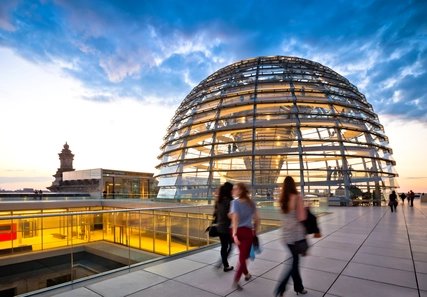
In the summer weeks before the reconstruction, Christo and Jeanne-Claude briefly covered the Reichstag and its history, after which they handed over the building to undergo extensive renovation work to make it fit for a new era.
A glacier? A silver mountain?
Some 200 tonnes of steel anchored the fabric to the ground, and the whole ensemble was tied up like a package with 15,600 metres of blue rope. How is something like this created? With cranes or scaffolding? Neither: Christo and Jeanne-Claude only wrapped the building with human assistance - in this case with the support of 90 professional climbers.
Between 24 June and 7 July 1995, a total of around five million visitors stood in awe in front of the high, silvery reams of fabric, watching the wind play with the fabric and then seeing how it reflected the colours in the sky. Reminiscent of a glacier, or perhaps a silver mountain? It was a magnificent sight, which created an unforgettable atmosphere between the people present.
Commercialisation: Nil return
The wrapping of the Reichstag cost some $15 million - without having any sponsors or subsidies. The Three Tenors, Pavarotti, Domingo and Carreras, wanted to sing in front of the Wrapped Reichstag, and the Berlin Philharmonic and Claudio Abbado also wanted to perform Fidelio there - but there was no chance of this happening. **
Christo and Jeanne-Claude founded a company back in the 1960s to buy and sell their art in order to fund their projects.
Christo says: “No one can buy these projects, no one can own them, no one can commercialise them, no one can charge admission to see them - not even we own these works. Our work is about freedom, and freedom is the enemy of all claim to ownership, and ownership is synonymous with duration. That is why the work cannot last.” ***
And so the Wrapped Reichstag did not endure either. Nothing remained, as all the materials were taken down and recycled - nothing that is, except the memory of it.
• *https://www.stern.de/kultur/kunst/christo--der-verhuellungskuenstler-zieht-im-stern-interview-bilanz-8672832.html
• ** https://sz-magazin.sueddeutsche.de/kunst/interview-christo-kuenstler-80864
• *** Jacob Baal-Teshuva: Christo & Jeanne-Claude. Taschen, Cologne 2001, ISBN 3-8228-6015-8, p. 82.
ABOUT BERLIN App
Find more powerful stories from Berlin on our app ABOUT BERLIN App. You can download it for free for iPhone and Android.



